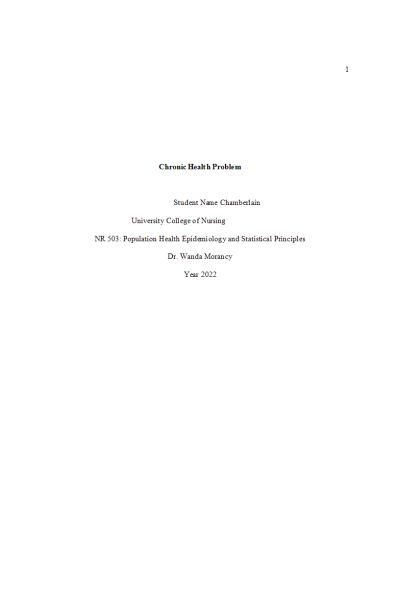NR 503 Week 6 Assignment; Epidemiological Analysis; Chronic Health Problem - Multiple sclerosis
-
$20.00
| Institution | NR 503 Population Health, Epidemiology & Statistical Principles |
| Contributor | Gonzale |
Chronic Health Problem
NR 503: Population Health Epidemiology and Statistical Principles
Chronic Health Problem
There are currently 2.8 million people worldwide that are living with multiple sclerosis (MS) which translates into approximately 1 in 3,000 persons having an MS diagnosis and in countries with the highest prevalence that equates to 1 in 300 persons (MSIF, 2020). This paper’s intent is to shed insight into this chronic health problem, its impact on those with the disease, analyze the epidemiological data, review the available screening tools and levels of prevention, and discuss a plan of action the nurse practitioner can utilize when dealing with patients suffering from multiple sclerosis.
Background and Significance
Multiple sclerosis is a chronic and often disabling autoimmune disease that is characterized by neurologic dysfunction due to lesions created as a result of the demyelination of the central nervous system (Zurawski & Stankiewicz, 2018). The actual pathogenesis of these lesions (or plaques) in the brain is currently unknown, however, it has been attributed by doctors and researchers to the inflammation of the nerves and the resulting destruction of the myelin (Tarlinton et al., 2019.) Myelin is a fatty, protein-based substance that surrounds and protects nerve fibers in the central nervous system. In cases of multiple sclerosis, the immune system of the patient attacks the myelin and destroys it leaving scar tissue called sclerosis (or lesions/plaques) and these damaged nerve areas become unable to properly conduct electrical impulses to and from the brain (URMC, 2018)............................... Continue
| Instituition / Term | |
| Term | Year 2022 |
| Institution | NR 503 Population Health, Epidemiology & Statistical Principles |
| Contributor | Gonzale |
















































![NR 503 Week 8 Discussion; Health Policy and Ethics - Maryland Department of Health [MDH], 2017 NR 503 Week 8 Discussion; Health Policy and Ethics - Maryland Department of Health [MDH], 2017](https://www.gradesbooster.com/image/cache/catalog/3422-80x80.png)

























